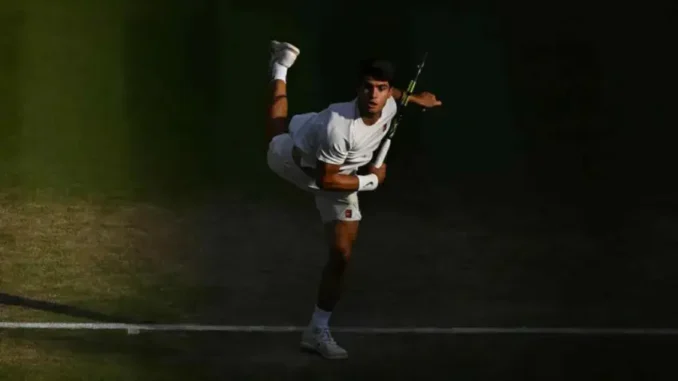
Carlos Alcaraz, the 22-year-old Spanish tennis sensation, has captivated the world with his explosive athleticism, creative shot-making, and unrelenting passion on the court. With five Grand Slam titles, including two Wimbledon crowns, two French Opens, and a US Open, he’s already cemented his status as a generational talent. Yet, as he prepares for the US Open 2025, where he’ll compete in mixed doubles alongside Emma Raducanu, one aspect of his game remains under scrutiny: his serve. Despite recent improvements, Alcaraz’s serve lacks the consistency needed to match the dominance of his groundstrokes and movement, a weakness that could hinder his pursuit of tennis immortality. As he aims to add to his 21 ATP Tour-level titles, experts and Alcaraz himself are focused on transforming this shot into a reliable weapon.
Alcaraz’s serve has long been identified as the missing link in an otherwise complete game. While his forehand and backhand are weapons of mass destruction, capable of dictating points with ferocious spin and precision, his serve has often been described as awkward and inefficient. In 2025, Alcaraz has worked diligently to address this, tweaking his service motion under the guidance of coach Juan Carlos Ferrero. “It’s something I’ve improved quite a lot,” Alcaraz said after firing 16 aces in a marathon Wimbledon win over Frances Tiafoe, clocking serves up to 135 mph. The changes, introduced before the 2024 clay season, involve a more fluid motion with a single pause instead of two, a looser wrist, and better weight transfer, resulting in a less tense delivery. “I’m really proud,” he noted after a strong serving performance in Madrid, where he hit aces at speeds exceeding 140 mph. “I’m working on it every day, not only on grass, but on clay, on hard courts, during the whole year.”
Statistically, Alcaraz’s serve has shown progress but remains a work in progress. In 2025, he’s landing 65.6% of first serves, averaging 2.93 aces per match, with a double-fault ratio of 2.4 per match in best-of-three-set contests. While these numbers reflect improvement—33% of his first serves go unreturned over the past year, a significant jump—his first-serve win percentage hovers around 70%, below the 75% mark of elite servers like Novak Djokovic. His second-serve win rate, critical for maintaining pressure, is even more concerning, dipping to 45% in some matches, as seen in his loss to Ugo Humbert indoors. “His loss was due to the second serve win-loss rate,” one analyst observed, noting that while Alcaraz’s first serve is decent for his 6-foot frame, his second serve lacks the consistency to deter aggressive returners.
The serve’s inconsistency is most evident in shorter matches and on faster surfaces like hard courts and indoors. Unlike his remarkable 14–1 record in five-set matches, where his athleticism and creativity shine in longer rallies, Alcaraz struggles in best-of-three formats, where a reliable serve is crucial for quick points. “On clay you can watch the real tennis,” Alcaraz said in Monte Carlo, praising long rallies where his ground game thrives. Yet, on faster surfaces, where points are shorter, his serve doesn’t provide the free points needed to dominate. His 53% first-serve percentage in the 2025 Wimbledon final against Jannik Sinner, coupled with seven double faults, allowed Sinner to pressure his serve, contributing to Alcaraz’s first Grand Slam final loss. “It’s difficult to lose,” Alcaraz admitted, acknowledging Sinner’s superior returning and consistency.
To address this, Alcaraz has embraced innovative training, including practicing his serve toss with a mini basketball hoop to improve accuracy. Social media posts from fans highlighted this creative approach, with one noting, “The toss is the most critical part of the serve to iron out.” He’s also added 5 grams of lead tape to his racket’s neck to enhance power, a change he tested before the 2025 Australian Open. “We had to try things,” Alcaraz said, emphasizing his commitment to evolution. These adjustments paid dividends at Queen’s Club, where he averaged 12 aces per match, and at Roland Garros, where his serve helped him stage a comeback against Sinner in a five-set epic. However, losses like the one to David Goffin in Miami, where he admitted to a “poor level” due to sloppy mistakes, highlight how serve inconsistency can exacerbate mental lapses.
Alcaraz’s candidness about his struggles adds depth to his journey. After a 2024 US Open loss, he admitted, “I’ve taken steps backwards, like I’m not doing well mentally,” and in Indian Wells 2025, he revealed feeling “nervous the whole day.” These moments suggest that serve inconsistency not only affects points but also his confidence, particularly under pressure. Experts like Paul Annacone, who coached Roger Federer, see Alcaraz’s potential to marry his grass-court brilliance with a Federer-like serve accuracy. “The best person on grass right now is Alcaraz,” Annacone said, praising his ability to transition from defense to attack in seconds. If Alcaraz can elevate his serve to match his groundstrokes, his 90.4% win rate in 2025 could climb even higher.
As Alcaraz prepares for the US Open, his serve remains a focal point. With Raducanu by his side in mixed doubles, he’ll need to rely on his improved motion to hold serve against top teams. While his charisma and highlight-reel playstyle—described by The Guardian as making him “arguably the most interesting athlete in the world right now”—keep fans enthralled, a consistent serve could unlock the next phase of his dominance, potentially pushing him past his current five majors toward double digits. For now, Alcaraz’s quest to become a “serve bot” continues, one toss at a time.
Leave a Reply